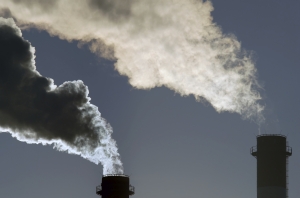Last Friday saw the late release of a series of reports, including new Auction Guidelines ahead of the next Emissions Reduction Fund auction in November, the release of the Review Report of the UNFCCC Taskforce and economic modelling undertaken for the DFAT in support of Australia’s new post-2020 target, and the release of the March 15 and December 14 quarterly update to the NGGI.
In this On Point, we provide an analyst reaction and notable findings.
ERF Auction Guidelines – Variable Volume Threshold
The Auction Guidelines released by the Clean Energy Regulator (CER) on Friday contained a new clearing mechanism enabling the Regulator to purchase between 50 and 100 per cent of abatement bid below the Benchmark Price. The new variable rule is an update to the 80 per cent clearing rule initially set by the government.
We view the variable threshold as an attempt to build pricing uncertainty in the ERF by adding another opaque layer to an already dark ERF market. By implementing the new rule, the Regulator is seeking to ‘have it both ways’ by maintaining a high benchmark price to encourage supply, while attempting to build downward price pressure to encourage low bids.
As noted by the CER, “the best strategy for success at the auction is to price realistically – the lowest price at which it is worth your while to commit to the project.”
In reality, however, the more opaque the market is, the less inviting it is, particularly for industry, which already views the ERF with a high degree of cynicism. Subsequently, we continue to view market and price transparency as a more effective means to encourage industry supply and competition should the Regulator be concerned with the wide spread of bids we estimate was submitted (and successful) at ERF I.
Despite the new rule, we continue to anticipate a high benchmark price at auction two. Recent analysis continues to indicate upside at the high end of our simulated ERF bid-stack for ERF II. As per auction one, most proponents are expected to contract above the average price disclosed by the Regulator, closer to the projected “highest clearing price”.
This suggests upside will again be available for proponents in line with their risk tolerance and their understanding of supply dynamics, particularly from large industry projects.
Review Report of the UNFCCC Taskforce & Economic Modelling
The release of the UNFCCC taskforce report and economic modelling shows that the review of Australia’s international emissions reduction targets was focused on Gross Domestic Product (GDP), with a particular emphasis on the energy sector. The influence on GDP growth was modelled to be greater the deeper the target chosen, however, this is the result of an assumption that reducing Australia’s emissions will lower GDP growth.
Average annual GDP growth under each target analysed is estimated to be above 2 per cent with growth rates ranging from 2.09 to 2.18 per cent a year. With the likelihood of an even smaller impact to GDP growth from falling technology costs in the electricity sector (not modelled), this suggests that a more ambitious target could readily have been adopted.
In seeking to meet the new target, figures released by the Department of Environment appear to indicate that 900 million tonnes of greenhouse gas emissions reduction will be required to meet the new 2030 target. As noted in our recent update, this cumulative shortfall is in the order of 1,600 Mt, suggesting a considerable discrepancy in government figures.
The release of economic modelling on Friday sheds some light into the assumptions which resulted in the government’s oversight.
Unlike the Emissions Reduction Fund, which seeks to cover the entire Australian economy, economic modelling of the 2030 target considers only energy sector emissions. The energy sector – by UNFCCC accounting – includes the combustion and fugitive emissions associated with stationary energy, transport, and fuel. No consideration was given to emissions from industrial process and product use, agriculture, waste, or land use, land use change and forestry.
Interestingly, the modelling assumes that Australia emissions will be 5 per cent lower than 2000 levels in 2020 through reducing coal generation and increasing gas and renewable energy. This is a predominately false assumption.
Besides the Renewable Energy Target (RET) and the ERF, which is expected to have a limited impact in reducing emissions in the electricity sector, the Government’s safeguard scheme is the only mechanism with the potential to limit coal generation. Based on previous analysis of the Safeguard scheme, this is unlikely to occur.
National Greenhouse Gas Inventory (NGGI)
The March 2015 quarterly update of Australia’s NGGI released by the Department of Environment (DoE) contained both the December and March quarter updates.
In a media release following the release of the updated figures, Environment Minister Greg Hunt suggested that ‘Australia’s emissions have fallen to their lowest level for a single quarter in 10 years’. This omits a 31 per cent quarterly increase in emissions from the land use, land use change and forestry (LULUCF) sector.
Considering Australia’s emissions on an annualised basis, and including LULUCF emissions, the lowest emissions in the last 10 years were actually achieved in the year ending July 2014 at a level of 540.8Mt, the last quarter of the carbon pricing mechanism. Since that point, on an annualised basis, emissions have risen by 4.3Mt, to 545.1 for the year ending March 2015.
Politicising aside, the notable change within the current update was an increase in LULUCF emissions due to increased deforestation in Queensland, as we explored in our recent Update. Further emissions increases were are attributed to the electricity sector between the December and March quarters due to a shift from natural gas generation to coal generation, with wholesale gas prices continuing to increase. Inversely fugitive emissions decreased over the December to March quarters due to a downturn in coal mining as a result of reduced export demand.
Kind Regards
The RepuTex Team
Australian Emissions Markets













